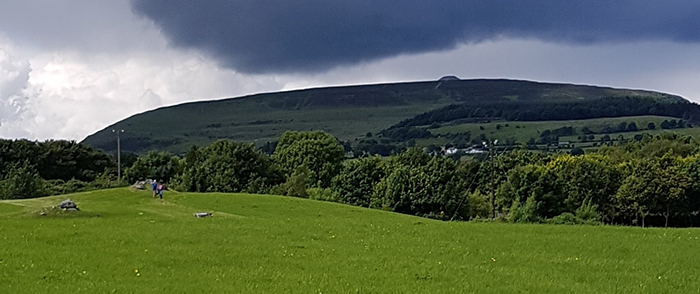Secrets in the Stones: Examining the Presence of Stones with Inclusions in the Passage Tombs of Atlantic Europe
PhD Candidate: Patricia Kenny
Supervisor: Dr Jessica Smyth
Funded By: (opens in a new window)Irish Research Council Government of Ireland Postgraduate Scholarship & the National University of Ireland Travelling Studentship Prize
The passage tombs of Atlantic Europe bear testament to a society capable of extraordinary feats of human engineering and creative expression. They were constructed from 4200BC – 3000BC, a time of great social upheaval, as burial places for Europe’s first farmers. Passage tombs are distributed across northwest Europe, with some of the grandest examples clustered in Ireland, Orkney, north Wales and Brittany.

As places used for the deposition of human remains, passage tombs played an essential role in Neolithic belief systems and were likely constructed using carefully selected and socially significant stones. Studying the physical properties of these stones can shed light on the cultural reasons behind stone selection. Stones with inclusions (SWI) are defined as structural stones which include fossils, mineral veins, mineral crystals or rock clasts. Researchers have noted the presence of SWI at passage tombs; however, no one has systematically examined these stones. Ethnographic research has discovered that some societies consider stones with geological inclusions to be culturally significant, and they are sometimes linked to belief systems.
In 2016, I conducted a pilot study of Irish passage tombs, and found that SWI are common and may demonstrate deliberate patterning. When this is considered alongside the aforementioned ethnographic research, it seems plausible that SWI were culturally significant in Neolithic Europe. This research will expand the pilot study, studying a representative sample of tombs from Ireland, north Wales, Orkney and Brittany. The presence of SWI will be analysed scientifically, using statistical and spatial analysis. Anthropological studies of indigenous groups will be reviewed, identifying those with beliefs about geological inclusions and using analogy to investigate what SWI may have meant in Neolithic Europe.
| Methodologically, this research can be divided into three main phases: The first phase, data collection, begins in Spring 2018, and involves visiting a majority of Irish passage tombs to quantify stones with inclusions at these sites. In Spring/Summer 2019, the Welsh and Scottish tombs will be visited, followed by the French tombs in Autumn 2019. This phase will also include a study of 30 tombs in relation to their local geology. This study will demonstrate the degree to which stones within passage tombs are influenced by the availability of stone types in the region. Phase Two will commence after collecting data from the Irish tombs and will continue until all sites are visited. This phase involves analysing the location of SWI within tombs, and identifying whether there are any significant patterns in the distribution of SWI. The use of SWI in different regions will be closely examined, to understand how this phenomenon varies both at a national and international scale. Phase Three is based upon reviewing ethnographic data, and identifying any societies that utilise SWI. Where possible, this data will be used to provide a possible explanation for patterns that are emerging in the archaeological data. |